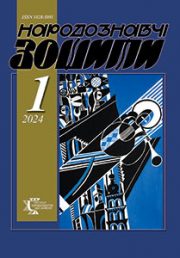The Ethnology Notebooks. 2022. № 6 (168), 1432—1438
UDK [[7.05:62]:378](477.8)”18/19″
DOI https://doi.org/10.15407/nz2022.06.1432
FEATURES OF THE FORMATION OF DESIGN IN ART AND INDUSTRIAL EDUCATION OF WESTERN UKRAINE
DYACHENKO Alla
- ORCID ID: https://orcid.org/0000-0003-4496-5931
- PhD in Science, Associate Professor of the Department
- of Industrial Design and Computer Technologies,
- Acting Dean of the Faculty of Decorative and Applied Arts,
- Kyiv State Institute of Decorative Art And Design Named M. Boychuk,
- 32, M. Boichuk (Kikvidze) str., 01014, Kyiv, Ukraine,
- Contacts: e-mail: alla.diachenko0107@gmail.com
Abstract. Introduction. Taking into account the relevance of the development of modern design education in Ukraine, especially important are questions that highlight the systematic, methodical foundations of teaching art education, which allow us to remember the best traditions of old schools, highlight new directions and identify the most effective methods of improving the curriculum.
Problem Statement. With the development of industrial production in Ukraine in the 19th century, design began to take shape as an independent type of professional activity. Therefore, the study of the problem of the emergence of pan-European trends in the development of design and its formation in the western Ukrainian lands in the 19th and early 20th centuries are relevant today, as the practical aspect is related to the need to raise the professional level of design specialists in higher education institutions.
The purpose is to determine the main stages of development and formation of design in art and industrial education in Western Ukraine.
Methods. Methods of analysis, synthesis, comparison, description and generalization were used to reveal the goal. The combination of these methods made it possible to highlight the peculiarities of the formation of design in the art and industrial education of Western Ukraine.
The results. The peculiarities of the formation and development of design in the art and industrial education of Western Ukraine at the end of the 19th and the beginning of the 20th century are highlighted. It was established that in the western Ukrainian lands artistic and industrial education was carried out according to general European cultural trends. The development of design education as the legal successor of the artistic and industrial education of Galicia is considered. The significant influence of the Lviv Art and Industry School on the art and industry education of Galicia was noted. The prerequisites for the formation of design education in the artistic and industrial education of Bukovyna and the main stages of its development have been clarified. The peculiarities of the formation of artistic and industrial education in Transcarpathia are revealed.
Conclusions. Based on the results of the research, we note that the foundations of professional education laid by our predecessors in the 19th century provided favorable conditions for the further development of the design school in Western Ukraine.
Keywords: design education, design activity, artistic and industrial education, Western Ukraine, Galicia, Bukovyna, Transcarpathia.
Received 2.11.2022
REFERENCES
- Verghunov, S.V. (2009). Design of Ukraine: aspects of development and development. Bulletin of KhDADM, 2, 18—31 [in Russian].
- Danylenko, V.Ja. (2006). Design of Ukraine in the world context of art and design culture of the 20th century (national and globalization aspects): dissertation… doctor of art history: 01.05.03. Ljvivsjka nacionaljna akademija mystectv. Lviv [in Ukrainian].
- Pavliv, A.P., & Miljchevych, S. (2004). On the question of the formation and development of design in Transcarpathia in the 19th and 20th centuries. Bulletin of Lviv Polytechnic University, 505, 393—396 [in Ukrainian].
- Prusak, V. (2017). Formation and development of design education in Ukraine (end of the 20th — beginning of the 21st century). Bulletin of the Lviv National Academy of Arts (Issue 31, pp. 71—82) [in Ukrainian].
- Djakiv, M.V. (2010). Urban furniture of Galicia XIX—XX centuries: history, typology, stylistic features: autoref. thesis …candidate art studies: 17.00.06. Prykarpat. nac. un-t im. V. Stefanyka; In-t mystectv. Ivano-Frankivsjk [in Ukrainian].
- Myghalj, S.P. (2000). Lviv School of Design: Development, Problems, Prospects. Dialogue of cultures: Ukraine in the world context. Art education: coll. of science works (Issue 5, pp. 387—399) [in Ukrainian].
- Miljchevych, S.I. (2005). On the question of the peculiarities of the formation and development of art and industrial education in Transcarpathia in the second half of the 19th and early 20th centuries. Bulletin of KhDADM, 1, 114—122 [in Ukrainian].
- Nebesnyk, I.I. (2000). Art education in Transcarpathia in the 20th century: historical and pedagogical aspect. Uzhghorod: Zakarpattja [in Ukrainian].
- Khiljko, I. (2005). Prerequisites for the development of art education in Bukovina (the end of the 19th — the first third of the 20th century). Proceedings. Series: Pedagogy and psychology (Issue 13, pp. 205—208) [in Ukrainian].
- Khiljko, I. (2007). Development of art education in Bukovina (second half of the 19th — 30s of the 20th century): autoref. thesis …candidate ped. sciences: 13.00.01. Prykarpatsjkyj nac. un-t im. V. Stefanyka. Ivano-Frankivsjk [in Ukrainian].
- Shmaghalo, R. (2005). Art education in Ukraine in the mid-19th — mid-20th centuries: structuring, methodology, artistic positions: autoref. thesis …doctor of art history: 17.00.06 «Decorative and applied art». Lviv. nac. akad. mystec. Lviv: LNAM [in Ukrainian].
- Shmaghalo, R.T. (2006). The historical path of the artistic and industrial school in Lviv (1876—1939; 1939—1944)]. Information issue, 8, 170—175 [in Ukrainian].
- (2011). Lviv Academy of Arts. Historical and image publication. Kyiv: VC Loghos Ukraine [in Ukrainian].
- Kolomyia is the center of pottery. Retrieved from: http://hutsul.museum/museum/articles/kolomya-keramika-schkola [in Ukrainian].
- Odrzywolski, S. (1914). A glance at the development of industrial education in Print from «School». Lviv [in Polish].






